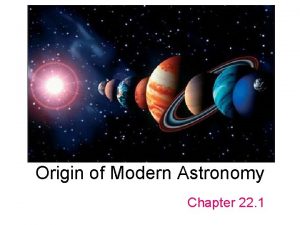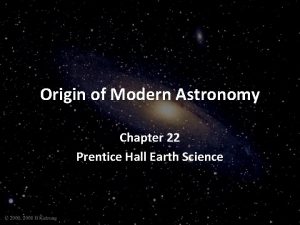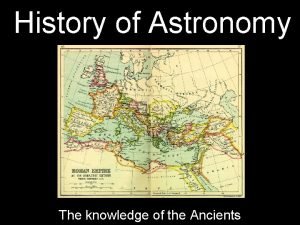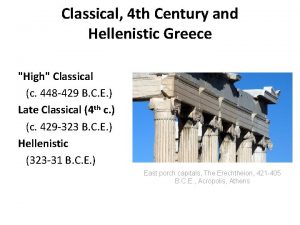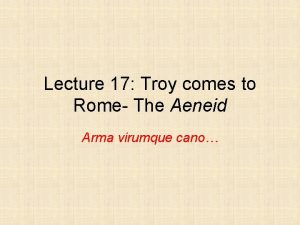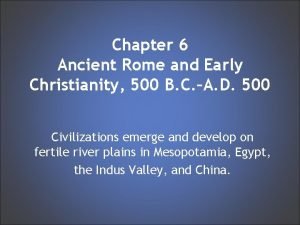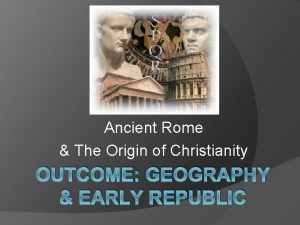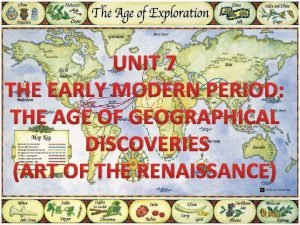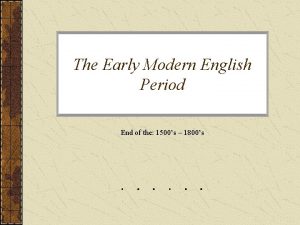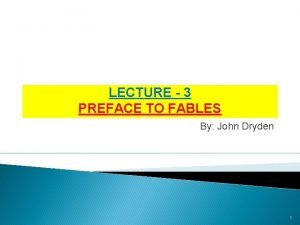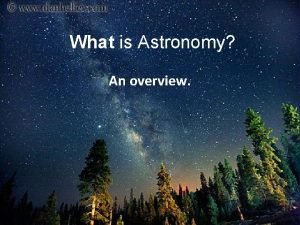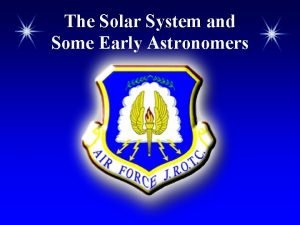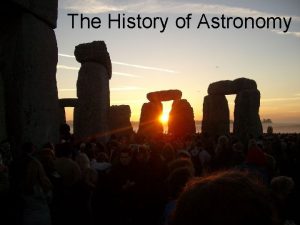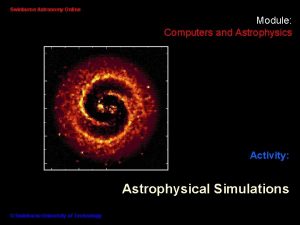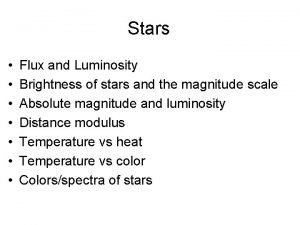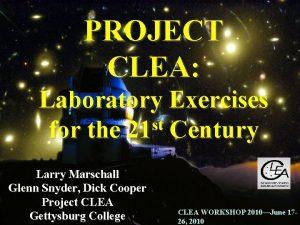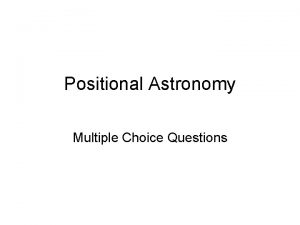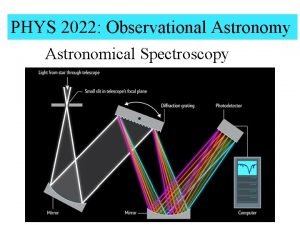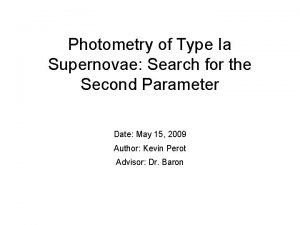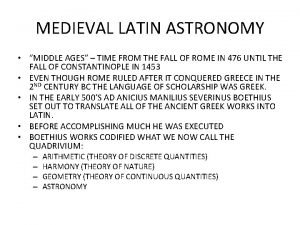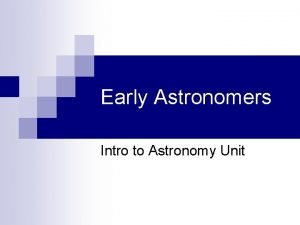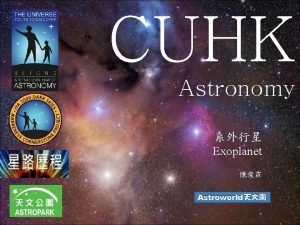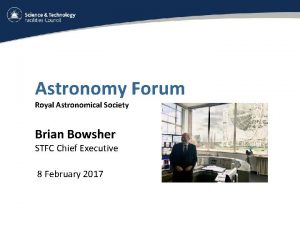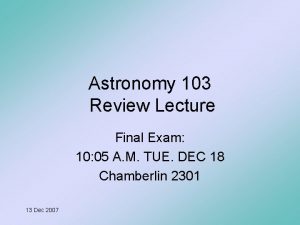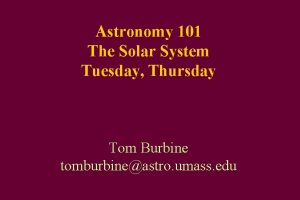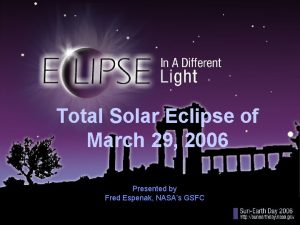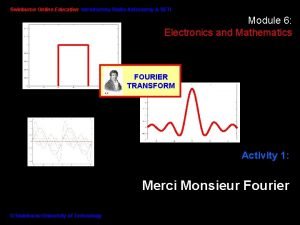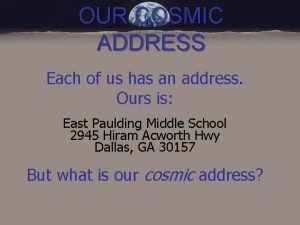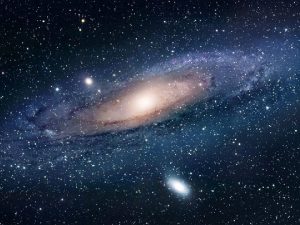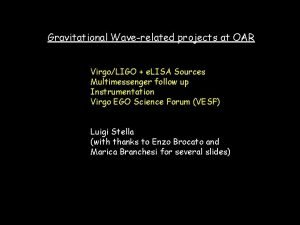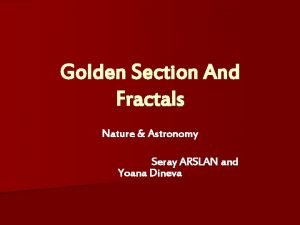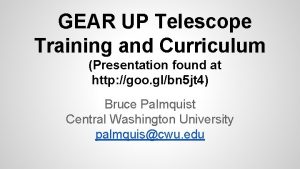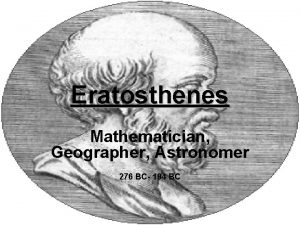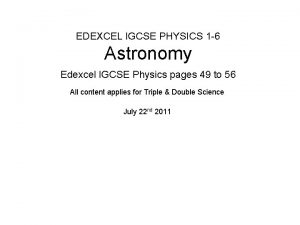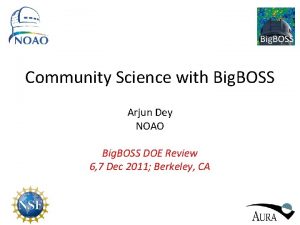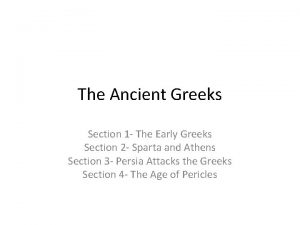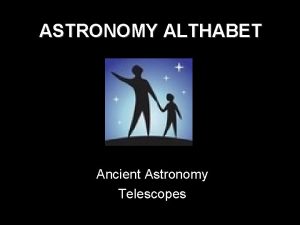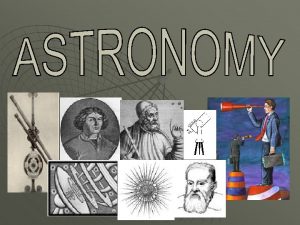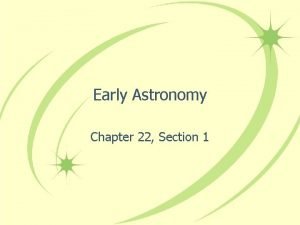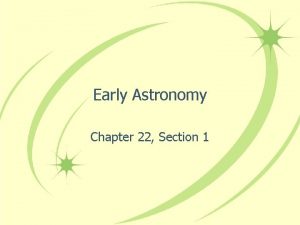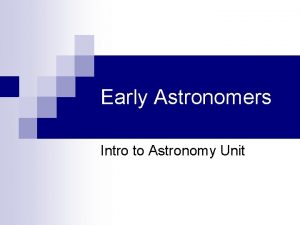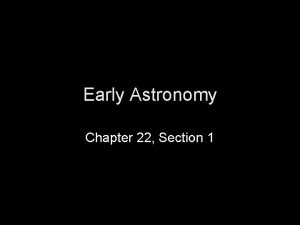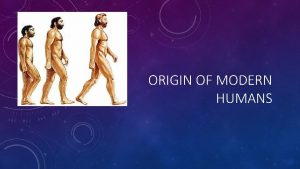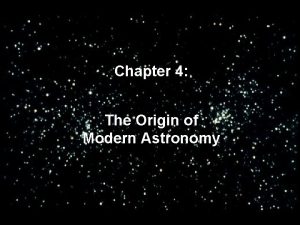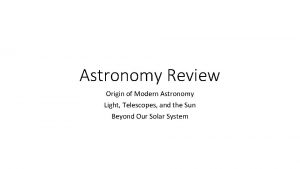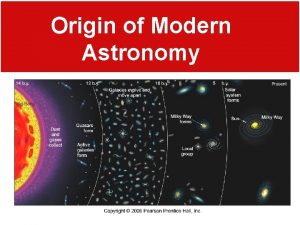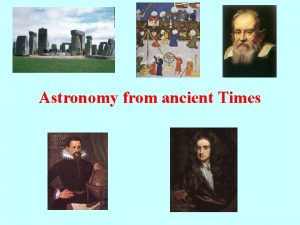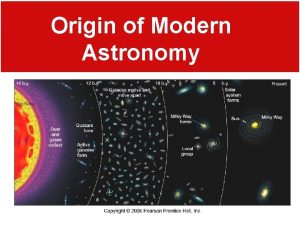Origin of Modern Astronomy Early Astronomy Ancient Greeks











































































- Slides: 75

Origin of Modern Astronomy

Early Astronomy Ancient Greeks Astronomy is the science that studies the universe. It includes the observation and interpretation of celestial bodies and phenomena. . The Greeks used philosophical arguments to explain natural phenomena The Greeks also used some observational data.

Early Astronomy Ancient Greeks Geocentric Model = Ptolemy Greek Astronomer • In the ancient Greeks’ geocentric model, the moon, sun, and the known planets—Mercury, Venus, Mars, and Jupiter—orbit Earth. Heliocentric Model = Nicolaus Copernicus • In the heliocentric model, Earth and the other planets orbit the sun.

Early Astronomy Ancient Greeks Ptolemaic System • Ptolemy created a model of the universe that accounted for the movement of the planets. • Retrograde motion is the apparent westward motion of the planets with respect to the stars. March Sept. April May Aug. East Feb. Jan. Dec. June July Retrograde motion of Mars West


Retrograde Motion

99 Years of Astronomy

Early Astronomy The Birth of Modern Astronomy Nicolaus Copernicus • Copernicus concluded that Earth is a planet. He proposed a model of the solar system with the sun at the center. Heliocentric Model This model explained the retrograde motion of planets better than the geocentric model.

Early Astronomy The Birth of Modern Astronomy Tycho Brahe • Tycho Brahe designed and built instruments to measure the locations of the heavenly bodies. Brahe’s observations, especially of Mars, were far more precise than any made previously. Johannes Kepler • Kepler discovered three laws of planetary motion: 1. Orbits of the planets are elliptical. 2. Planets revolve around the sun at varying speed. 3. There is a proportional relationship between a planet’s orbital period and its distance to the sun.

Early Astronomy The Birth of Modern Astronomy German astronomer Johannes Kepler (1571 -1630) helped establish the era of modern astronomy by deriving three laws of planetary motion.

Johannes Kepler • 1599 – Kepler hired by Tycho Brahe – Work on the orbit of Mars • 1609 – Kepler’s 1 st and 2 nd Laws – Planets move on ellipses with the Sun at one focus – The radius vector sweeps out equal areas in equal times • 1618 – Kepler’s 3 rd Law – The square of a planet’s orbital period P is proportional to the cube of its semi-major axis R. R

Early Astronomy Johannes Kepler used Tycho Brahe’s data to develop three laws that explained the motions of the planets. Earth’s orbit June 15 th Equal areas (30 days) July 15 th January 15 th (30 days) Sun December 15 th KEPLER’S EQUAL AREA LAW states that a line connecting Earth to the sun will pass over equal areas of space in equal times. Because Earth’s orbit is elliptical, Earth moves faster when it is nearer to the sun.

Early Astronomy Equal areas law Faster Slower KEPLER’S EQUAL AREA LAW states that a line connecting Earth to the sun will pass over equal areas of space in equal times. Because Earth’s orbit is elliptical, Earth moves faster when it is nearer to the sun.

Early Astronomy Galileo Galilei Italian scientist Galileo Galilei (1564— 1642) used a new invention, the telescope, to observe the Sun, Moon, and planets in more detail than ever before.

Early Astronomy The Birth of Modern Astronomy Galileo Galilei • Galileo’s most important contributions were his descriptions of the behavior of moving objects. • He developed his own telescope and made important discoveries: 1. Four satellites, or moons, orbit Jupiter. 2. Planets are circular disks, not just points of light. 3. Venus has phases just like the moon. 4. The moon’s surface is not smooth. 5. The sun has sunspots, or dark regions.


Early Astronomy Sir Isaac Newton English scientist Sir Isaac Newton (1642— 1727) explained gravity as the force that holds planets in orbit around the Sun.

Early Astronomy The Birth of Modern Astronomy Sir Isaac Newton • Although others had theorized the existence of gravitational force, Newton was the first to formulate and test the law of universal gravitation. The universal law of gravitation, helped explain the motions of planets in the solar system. Universal Gravitation • Gravitational force decreases with distance. • The greater the mass of an object, the greater is its gravitational force.

Gravity’s Influence on Orbits

Newton’s Laws of Motion • 1 st Law – A body at rest, or in uniform motion, will remain so unless acted upon by an unbalanced force • 2 nd Law – The change in motion (acceleration) acceleration is proportional to the unbalanced force • 3 rd Law – For every action there is an equal and opposite reaction

Gravity • Gravity is the force that – holds us to the Earth – causes a rock to fall towards the ground – causes the Earth to go around the Sun – causes the Sun to be pulled towards the center of the Milky Way galaxy • Gravity acts between any two objects even if they are far apart. – “action at a distance” distance

Summary • Kepler’s and Galileo’s Laws provided Newton with important clues that helped him formulate his laws of motion • Newton arrived at 3 laws that govern the motion of objects – The law of inertia – The law of force – The law of action and reaction • Newton also arrived at a law of gravity – But it seemed to require action at a distance!

Earth Science Light and Astronomical Observations

Important Astronomical Measurements • An ellipse is an oval-shaped path. An astronomical unit (AU) is the average distance between Earth and the sun; it is about 150 million kilometers. Light-year The distance that light travels in one year, about 9. 5 trillion kilometers. Parsec: A unit of measurement used to describe distances between celestial objects, equal to 3. 258 lightyears.

The study of light Electromagnetic radiation • Visible light is only one small part of an array of energy • Electromagnetic radiation includes • Gamma rays • X-rays • Ultraviolet light • Visible light • Infrared light • Radio waves *Energy radiated in the form of a wave, resulting from the motion of electric charges and the magnetic fields they produce.

The study of light v. Electromagnetic radiation • All forms of radiation travel at 300, 000 kilometers (186, 000 miles) per second v. Light (electromagnetic radiation) can be described in two ways A continuum depicting the range of v. Wave model v. Wavelengths of radiation vary electromagnetic radiation, with the longest wavelength at one end and the shortest at the other. v. Radio waves measure up to several kilometers long v. Gamma ray waves are less than a billionth of a centimeter long v. White light consists of several wavelengths corresponding to the colors of the rainbow

v. Light (electromagnetic radiation) can be described in two ways • Particle model • Particles called photons • Exert a pressure, called radiation pressure, on matter • Shorter wavelengths correspond to more energetic photons

The study of light v. Spectroscopy • The study of the properties of light that depend on wavelength • The light pattern produced by passing light through a prism, which spreads out the various wavelengths, is called a spectrum (plural: spectra)

The study of light A spectrum is produced when white light passes through a prism

The study of light v. Spectroscopy • Types of spectra • Continuous spectrum: A spectrum that contains all colors or wavelengths. • Produced by an incandescent solid, liquid, or high pressure gas • Uninterrupted band of color • Dark-line (absorption) spectrum • Produced when white light is passed through a comparatively cool, low pressure gas • Appears as a continuous spectrum but with dark lines running through it

Formation of the three types of spectra

Emission spectrum of hydrogen Emission Spectrum Absorption Spectrum A spectrum consisting of individual lines at characteristic wavelengths produced when light passes through an incandescent gas; a bright-line spectrum. A continuous spectrum crossed by dark lines produced when light passes through a nonincandescent gas. Absorption Spectrum of Hydrogen

The study of light v. Doppler effect • The apparent change in wavelength of radiation caused by the relative motions of the source and observer • Used to determine • Direction of motion • Increasing distance – wavelength is longer ("stretches") • Decreasing distance – makes wavelength shorter ("compresses") • Velocity – larger Doppler shifts indicate higher velocities

The Doppler effect Originally discovered by the Austrian mathematician and physicist, Christian Doppler (1803 -53), this change in pitch results from a shift in the frequency of the sound waves.

The Doppler effect The electromagnetic radiation emitted by a moving object also exhibits the Doppler effect. • Redshift, a phenomenon of electromagnetic waves such as light in which spectral lines are shifted to the red end of the spectrum.

The Doppler effect Blueshift: This spectrum shows hydrogen shifted to the blue end of the spectrum. This star is moving toward Earth. The radiation emitted by an object moving toward an observer is squeezed; its frequency appears to increase and is therefore said to be blueshifted. In contrast, the radiation emitted by an object moving away is stretched or redshifted. Blueshifts and redshifts exhibited by stars, galaxies and gas clouds also indicate their motions with respect to the observer. Redshift: This spectrum shows hydrogen shifted to the red end of the spectrum. This star is moving away from Earth.

Astronomical tools v. Optical (visible light) telescopes • Two basic types (1) Refracting telescope • Uses a lens (called the objective) to bend (refract) the light to produce an image • Light converges at an area called the focus • Distance between the lens and the focus is called the focal length • The eyepiece is a second lens used to examine the image directly • Have an optical defect called chromatic aberration (color distortion)

A simple refracting telescope

Astronomical tools v. Optical (visible light) telescopes • Two basic types (2) Reflecting telescope • Uses a concave mirror to gather the light • No color distortion • Nearly all large telescopes are of this type

A prime focus reflecting telescope

Cassegrain focus reflecting telescope

Newtonian focus reflecting telescope

The 200" (5 m) Hale Reflector of Palomar Observatory is shown above. Until recently it was the world's largest optical/infrared telescope.

Astronomical tools v. Optical (visible light) telescopes • Properties of optical telescopes • Light-gathering power • Larger lens (or mirror) intercepts more light • Determines the brightness • Resolving power • The ability to separate close objects • Allows for a sharper image and finer detail

Astronomical tools v. Optical (visible light) telescopes • Properties of optical telescopes • Magnifying power • The ability to make an image larger • Calculated by dividing the focal length of the objective by the focal length of the eyepiece • Can be changed by changing the eyepiece • Limited by atmospheric conditions and the resolving power of the telescope • Even with the largest telescopes, stars (other than the Sun) appear only as points of light

Astronomical tools v. Detecting invisible radiation • Radio radiation • Gathered by "big dishes" called radio telescopes • Large because radio waves are about 100, 000 times longer than visible radiation • Often made of a wire mesh • Have rather poor resolution • Can be wired together into a network called a radio interferometer

Radio Telescope A steerable radio telescope at Green Bank, West Virginia

Astronomical tools v. Detecting invisible radiation • Radio radiation • Gathered by "big dishes" called radio telescopes • Advantages over optical telescopes • Less affected by weather • Less expensive • Can be used 24 hours a day • Detects material that does not emit visible radiation • Can "see" through interstellar dust clouds

Radio Telescope The 300 -meter radio telescope at Arecibo, Puerto Rico

The Big Bang Theory The theory holding that the universe originated from the instant expansion of an extremely small agglomeration of matter of extremely high density and temperature.

Photons converted into particleantiparticle pairs and vice-versa E = mc 2 Early universe was full of particles and radiation because of its high temperature


The Big Band Theory • Evidence for Big Bang • This is theory of the universe’s earliest moments. • It presumes that the universe began from a tiny, hot, and dense collection of matter and radiation. • It describes how expansion and cooling of particles could have led to the present universe of stars and galaxies. • It explains several aspects of today’s universe with a very good accuracy.

The Big Band Theory The Big Bang theory is a model, which explains some facts (observations). It should be able to make predictions that can be verified through observations or experiments. Two important predictions: 1. Cosmic microwave background radiation. 2. Fusion of original hydrogen into helium.

Evidence for the Big Bang The Cosmic Background Radiation (Microwaves) Penzias & Wilson (1962) discovered an isotropic background microwave signal during testing a microwave antenna at Bell Labs in 1965. The noise was found to be coming from every direction. At the same time, physicists from Princeton calculated the expected radiation from the initially hot universe. They suggested that this radiation could be detected with a microwave antenna. The result was a Nobel Prize in physics for 1978.

The Cosmic Microwave Background

The Cosmic Background Radiation (Microwaves) Background radiation from Big Bang has been freely streaming across universe since atoms formed at temperature ~ 3, 000 K: visible/IR

The Cosmic Microwave Background The background consists of photons (radiation) arriving at Earth directly from the end of the era of nuclei (when the Universe was about 380, 000 years old). Neutral atoms captured most of the electrons. Photons were released and have flown freely through the universe ever since. This background radiation can be detected with a small TV antenna as part (1%) of static “snow”. The redshifted spectrum of the background radiation has now a temperature of 2. 73 K.

Cosmic Background Explorer The first satellite built dedicated to cosmology. Its goals were to investigate the cosmic microwave background radiation (CMB) of the universe and provide measurements that would help shape our understanding of the cosmos.

Cosmic Background Explorer This work helped cement the big-bang theory of the universe. According to the Nobel Prize committee, "the COBE-project can also be regarded as the starting point for cosmology as a precision science". Two of COBE's principal investigators, George Smoot and John Mather, received the Nobel Prize in Physics in 2006.

Cosmic Background Explorer

Cosmic Background Explorer The "famous" map of the CMB anisotropy formed from data taken by the COBE spacecraft.

Evidence for the Big Bang In 1927, the Belgian priest Georges Lemaître was the first to propose that the universe began with the explosion of a primeval atom.

Evidence for the Big Bang Edwin Hubble found experimental evidence to help justify Lemaître's theory. He found that distant galaxies in every direction are going away from us with speeds proportional to their distance (the redshift). The big bang was initially suggested because it explains why distant galaxies are traveling away from us at great speeds. The theory also predicts the existence of cosmic background radiation (the glow left over from the explosion itself). The Big Bang Theory received its strongest confirmation when this radiation was discovered in 1964 by Arno Penzias and Robert Wilson, who later won the Nobel Prize for this discovery.

Hubble’s Evidence • Doppler shifting - wavelength emitted by something moving away from us is shifted to a lower frequency • Sound of a fire truck siren - pitch of the siren is higher as the fire truck moves towards you, and lower as it moves away from you • Visible wavelengths emitted by objects moving away from us are shifted towards the red part of the visible spectrum • The faster they move away from us, the more they are redshifted. Thus, redshift is a reasonable way to measure the speed of an object (this, by the way, is the principal by which radar guns measure the speed of a car or baseball) • When we observe the redshift of galaxies outside our local group, every galaxy appears to be moving away from us - universe is expanding.

Expansion of universe has redshifted thermal radiation from that time to ~1000 times longer wavelength: microwaves

Evidence for the Big Bang Theory - Evidence for the Theory What are the major evidences which support the Big Bang theory? • First of all, we are reasonably certain that the universe had a beginning. • Second, galaxies appear to be moving away from us at speeds proportional to their distance. This is called "Hubble's Law, " named after Edwin Hubble (18891953) who discovered this phenomenon in 1929. This observation supports the expansion of the universe and suggests that the universe was once compacted.

Evidence for the Big Bang • Third, if the universe was initially very, very hot as the Big Bang suggests, we should be able to find some remnant of this heat. In 1965, Radioastronomers Arno Penzias and Robert Wilson discovered a 2. 725 degree Kelvin (-454. 765 degree Fahrenheit, -270. 425 degree Celsius) Cosmic Microwave Background radiation (CMB) which pervades the observable universe. This is thought to be the remnant which scientists were looking for. Penzias and Wilson shared in the 1978 Nobel Prize for Physics for their discovery.

Evidence for the Big Bang • Finally, the abundance of the "light elements" Hydrogen and Helium found in the observable universe are thought to support the Big Bang model of origins.

Synthesis of Helium • The current CMB temperature tells us precisely how hot the universe was when it appeared. • It tells us how much helium was initially produced. • A helium nucleus contains 2 protons and 2 neutrons. • At T > 1011 K, nuclear reactions converted protons into neutrons and back, keeping their numbers nearly equal. • Between 1010 and 1011 K, neutron – proton reactions favor protons, because neutrons are heavier than protons.

Synthesis of Helium • Energy is required to convert protons to neutrons. • At T < 1010 K, only neutrons can be changed into protons. • However, fusion continued to operate • and protons and neutrons combined into deuterium. • Then deuterium fused into helium. • During the early era of nucleosynthesis, helium nuclei were being destroyed by gamma-rays. • At ~1 minute, gamma-rays were gone and the proton – neutron ratio was set to 7: 1.

Synthesis of Helium Big Bang theory prediction: 75% H, 25% He (by mass) Matches observations of nearly primordial gases

Synthesis of Helium Abundances of other light elements agree with Big Bang model having 4. 4% normal matter – more evidence for WIMPS!


Nebular Hypothesis of Solar System Formation.
 Origin of modern astronomy chapter 22
Origin of modern astronomy chapter 22 Chapter 22 origin of modern astronomy answer key
Chapter 22 origin of modern astronomy answer key Ancient greek values
Ancient greek values Facts about geocentric theory
Facts about geocentric theory Learning astronomy by doing astronomy activity 1 answers
Learning astronomy by doing astronomy activity 1 answers Learning astronomy by doing astronomy
Learning astronomy by doing astronomy Learning astronomy by doing astronomy activity 1 answers
Learning astronomy by doing astronomy activity 1 answers Astronomy in ancient rome
Astronomy in ancient rome Why did the delian league break apart
Why did the delian league break apart The greeks based their ideal of beauty on
The greeks based their ideal of beauty on Why did the tyrants fall out of favor
Why did the tyrants fall out of favor Empire period floral design
Empire period floral design Romans and greeks
Romans and greeks Geometric mass floral design
Geometric mass floral design Above all else i must be saved
Above all else i must be saved Greeks
Greeks Doci timeo danaos
Doci timeo danaos What tools did the greeks use in geometric constructions
What tools did the greeks use in geometric constructions Option greeks wikipedia
Option greeks wikipedia Early cpr and early defibrillation can: *
Early cpr and early defibrillation can: * Lesson 1 early civilizations
Lesson 1 early civilizations Ancient rome and early christianity
Ancient rome and early christianity Early empires in the ancient near east
Early empires in the ancient near east Ancient rome outcomes geography and early republic
Ancient rome outcomes geography and early republic Ancient rome and early christianity chapter 6
Ancient rome and early christianity chapter 6 Means of communication in ancient times
Means of communication in ancient times Ancient india vs ancient china
Ancient india vs ancient china Early modern period dates
Early modern period dates Neoclassical period timeline
Neoclassical period timeline Early modern english syntax
Early modern english syntax Early modern english
Early modern english Gary ives west yorkshire study
Gary ives west yorkshire study Pre classical school of criminology
Pre classical school of criminology Early modern english period
Early modern english period Early modern english
Early modern english Intro to romeo and juliet
Intro to romeo and juliet Ancient and modern 239
Ancient and modern 239 Covenant
Covenant Chaucer as a father of english poetry slideshare
Chaucer as a father of english poetry slideshare Ancient olympics vs modern olympics
Ancient olympics vs modern olympics Ancient classical and modern biotechnology
Ancient classical and modern biotechnology 776bce
776bce Ancient olympics vs modern olympics venn diagram
Ancient olympics vs modern olympics venn diagram What is astronomy
What is astronomy Claudius ptolemy astronomy contributions
Claudius ptolemy astronomy contributions Aristotle astronomy
Aristotle astronomy Swinburne astronomy online
Swinburne astronomy online Stellar flux
Stellar flux Luminosity and flux
Luminosity and flux Clea astronomy
Clea astronomy Astronomy questions and answers multiple choice
Astronomy questions and answers multiple choice Phys2022
Phys2022 Distance ladder astronomy
Distance ladder astronomy Astronomy in medieval times
Astronomy in medieval times Geology earth science definition
Geology earth science definition Claudius ptolemy astronomy contributions
Claudius ptolemy astronomy contributions Cuhk astronomy
Cuhk astronomy Astronomy vs astrology definition
Astronomy vs astrology definition Astronomy forum uk
Astronomy forum uk Astronomy 103 final exam
Astronomy 103 final exam Astronomy 101 formulas
Astronomy 101 formulas Astronomy science fair projects
Astronomy science fair projects Astronomy picture of the day march 29 2006
Astronomy picture of the day march 29 2006 Time domain astronomy
Time domain astronomy Diferença entre eclipse lunar e solar
Diferença entre eclipse lunar e solar Cosmic address in order
Cosmic address in order Astronmo
Astronmo Radio astronomy lectures
Radio astronomy lectures Astronomy picture of the day
Astronomy picture of the day Time domain astronomy
Time domain astronomy Golden ratio in astronomy
Golden ratio in astronomy Telescope training
Telescope training 276 bc
276 bc Astronomy igcse
Astronomy igcse Michigan state university astronomy
Michigan state university astronomy Time domain astronomy
Time domain astronomy
